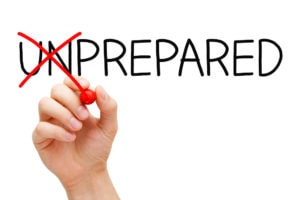
Are you ready for a company crisis?
Does your organization have a company crisis plan in place?
If you have a crisis plan, how long since it’s been updated?
Are your spokespeople trained and ready for a crisis?
Do employees know how to recognize a potential crisis and take action to head it off?
If you answered “no” to any of these questions, this blog is for you.
Most of us don’t spend much time thinking about a crisis happening at our organization. Hopefully, no crisis will ever strike.
But if a crisis does occur, are you prepared?
What if there’s an accident at your company’s headquarters? Or if a well-known executive falls gravely ill? What if an employee is in the news for an alleged crime?
Believe it or not, all of those crises have happened during my corporate career.
It takes only one crisis to damage an organization’s brand, reputation, and customer confidence. In fact, reputation can account for 63% of your company’s market value.
Every crisis casts a company as a hero, victim or villain. A good crisis plan helps shape the crisis narrative so that your company comes out on top.
The good news? 84% of companies have “some kind of action plan in place.”
The bad news? Companies seldom review their plans. In effect, many companies have only paper plans, and lack crisis readiness. Most companies have not:
- Trained employees to recognize the signs of a potential crisis.
- Identified the types of crises most likely to befall them.
- Anticipated the degree of risk from each type of crisis.
- Prepared local spokespersons to address a crisis in its critical first hours.
With a little preparation and some employee training, you can minimize your risk of damage if a crisis does occur.
Create a crisis plan
If you don’t already have a written crisis plan, make one as soon as possible.
Your plan should be simple enough to work for most crisis scenarios, yet detailed enough that even people who lack training can follow it.
A good crisis plan has the following components:
- Goals for the best outcome, to keep everyone focused. For example, one of your organizations’ goals could be to make sure your key stakeholders always stay informed. Many companies list protecting their brand as one of their first goals.
- Questions to assess the situation. The right questions are a critical component, since they help you recognize a potential crisis in time to prevent it.
- Members of the core team. These should include, but are not limited to, CEO, General Counsel, Head of Communications, etc.
- Steps to take once it’s clear that you face a crisis or a potential crisis. These steps should include assembling a core team, collecting and verifying the facts, creating a Message Map, and notifying key internal and external stakeholders.
- Checklists of actions to take in each area, from safety and security, to business continuity, notifying family members, employees, clients, and potentially the news media.
For more tips on communicating during a crisis, click here for a free crisis communications checklist.
Train your spokespeople on your crisis plan
Many crises involve speaking on news and social media. In our digital age, news travels quickly, so it’s likely that the news media will call before you’re ready to speak.
If you don’t have at least two or three spokespeople trained to respond publicly in a crisis, it’s crucial to act now. Training spokespersons and your crisis team is low-cost insurance compared with the costs of a crisis.
If your organization has multiple key locations, you should consider training a site leader at each location.
Test your crisis plan
Once you’ve created your crisis plan and trained key spokespeople, you need to test your plan. You’ll need about a half-day to do this.
Start by thinking of the crisis scenarios that are most likely to happen to your organization. Unfortunately, there are many scenarios to anticipate. Natural disasters. Hackers breaking into your data. Workplace accident. Unseemly activity by an executive. Workplace violence. Product malfunctions. Shareholder lawsuits.
Appoint two moderators to create and run the test, and never advise the participants in advance of the crisis scenario you will rehearse.
Conduct your test as if it’s a true crisis was actually unfolding. Do not reveal all of the information at once, since in a real crisis, no one receives all of the information in a tidy package.
As you rehearse, take every step you would take In a real crisis, up to notifying your CEO and executives.
Guide your core team step-by-step through the plan, and make notes where the plan needs improvements.
The test will show you whether your crisis plan will be a good enough guide in a real crisis.
Need help to create, rehearse or test a crisis plan? Contact us for a free consultation.
Train employees on your company crisis plan
Once your plan is approved and tested, make sure your organization’s employees are aware the plan exists and know how to recognize a potential crisis.
I coach clients to make a list of questions to help employees recognize and report issues before they can turn into a full-blown crisis.
Questions should include everything from a potential risk to health and human safety to asking if a situation requires notifying employees, clients or a government agency.

Ensure when you train your employees that you emphasize the word “potential.” Does the event or situation have the potentialto turn into a crisis?
Your list of questions should include contact information for people who can get to the answers quickest. Widely distribute the list of questions, both in paper and digital formats.
Update your crisis plan
You have a tested plan, ready spokespeople and trained employees. You’re done, right?
Not so fast.
Like everything else, crisis plans need to be updated at least once a year, and when any key executive or site leader changes.

We all hope a crisis never happens in our organization. Unfortunately, hope doesn’t prevent a crisis or get you through one successfully. With a good plan and a little preparation, you can handle a crisis quickly and with confidence.
Need help to prepare for a crisis? Contact us for a free consultation today.
Related Posts
Content Marketing: 7 Ways To Break Through in 7 Seconds
Win buyers’ attention fast! Boil your message down to 7 seconds. One thing’s for sure this New Year: your buyers are super-busy. They’re bombarded...
Use appealing words to grab audience attention
Grab their attention with appealing words. We all know our buyers are busy. At best they quickly skim our copy, if they even bother...
Panel presentations: Does speaker order really matter?
On speaker panels, does the panelist order matter? If you’ve ever attended or spoken on a panel, you know it’s hard to make a...
Still struggling with video meetings? Read these tips
Due to the pandemic, many of us have now logged months of working from home and participating in video meetings. We’ve spruced up our...






